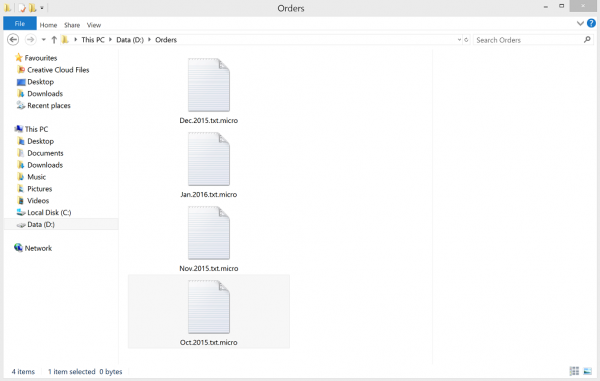TeslaCrypt 3.0 has been recently spotted by IT security experts to be using the .micro file extension. Meanwhile, a number of users detected the infection on their computer systems.

The virus promptly reports on its invasion. It issues a message called a ransom note. The message states the data on the affected device has been modified with a specific encryption algorithm. That entails the relevant software cannot read the data. Important files are no longer available to the victims.
In order to restore the encrypted files that have the .micro extension, the users are invited by the ransomware to pay the ransom. The amount varies from case to case. It is always to be paid in bitcoins. This further aggravates the detection of scammers behind the ransomware. Another obstacle is that the ransomware developers usually do not spread its copies directly. Instead, they employ affiliates. The affiliates are unrelated and typically are not personally acquainted with TeslaCrypt 3.0 developers. That is, even if you arrest a distributor, the malware developers are most likely to remain unknown.
Paying the ransom is not encouraged whatsoever.
.micro file virus exists is several editions. Some of the previous versions have been duly scrutinized. IT experts were able to offer a working remedy capable of dealing with impacts of the invasion. The resulted solutions either were able to undo the encryption or recover the latest copies of the scrambled files.
Again, so far, this is not the case with .micro file virus. Needless to say, the removal of TeslaCrypt 3.0 infection, as such, does not decrypt the data. It is due to be completed after sufficient data recovery effort has been taken.
.micro file virus target basically any data on a compromised machine. The infection scans any mapped drives available. Nearly any data is subject to the detection. The virus may omit only the files of extremely random extension. Hence, users face the need to recover almost all the files stored on their devices.
In order to get rid of .micro file virus, you will need to detect and remove all the files and registry entries associated with the threat. Kindly consult reliable malware removal guides to ensure proper extermination of the cryptic malware, as well the recovery of any decrypted data.
Automatic removal of .micro file virus
The benefits of using the automatic security suite to get rid of this infection are obvious: it scans the entire system and detects all potential fragments of the virus, so you are a few mouse clicks away from a complete fix.
- Download and install recommended malware security suite
- Select Start Computer Scan feature and wait until the utility comes up with the scan report. Proceed by clicking on the Fix Threats button, which will trigger a thorough removal process to address all the malware issues compromising your computer and your privacy.
Unlock files encrypted by .micro file virus
TeslaCrypt 3.0 (aka .micro file virus) represents a unique category of malicious software whose attack surface reaches beyond the operating system and its components, which is why removing the virus itself is a part of the fix only. As it has been mentioned, it encrypts one’s personal information, so the next phase of the overall remediation presupposes reinstating the files that will otherwise remain inaccessible.
-
Launch data recovery software
Similarly to the rest of its fellow-infections, .micro file virus most likely follows an operational algorithm where it erases the original versions of the victim’s files and actually encrypts their copies. This peculiarity might make your day, because forensics-focused applications like Data Recovery Pro are capable of restoring the information that has been removed. As the virus further evolves, its modus operandi may be altered – in the meanwhile, go ahead and try this.
-
Take advantage of Volume Shadow Copy Service
This technique is based on using the native backup functionality that’s shipped with Windows operating system. Also referred to as Volume Snapshot Service (VSS), this feature makes regular backups of the user’s files and keeps their most recent versions as long as System Restore is on. .micro file virus hasn’t been found to affect these copies therefore the restoration vector in question is strongly recommended. The two sub-sections below highlight the automatic and manual workflow.
- a) Use Shadow Explorer
Shadow Explorer is an applet that provides an easy way of retrieving previous versions of files and folders. Its pro’s include an intuitive interface where the computer’s entire file hierarchy is displayed within one window. Just pick the hard disk volume, select the object or directory to be restored, right-click on it and choose Export. Follow the app’s prompts to get the job done.

- b) Use file properties
Essentially, what the above-mentioned Shadow Explorer tool does is it automates the process that can otherwise be performed manually via the Properties dialog for individual files. This particular approach is more cumbrous but just as effective as its software-based counterpart, so you can proceed by right-clicking on a specific file, which has been encrypted by .micro file virus, and selecting Properties in the context menu. The tab named Previous Versions is the next thing to click – it displays available versions of the file by date of the snapshot creation. Pick the latest copy and complete the retrieval by following the prompts.

-
Data backups work wonders
Ransomware like so-called .micro file virus, isn’t nearly as almighty and destructive in case you run regular file backups to the cloud or external data media. The virus itself can be completely removed in a matter of minutes, and the distorted information can then be just as easily recovered from the backup. Luckily, this is a growing trend, so ransom Trojans are hopefully going to become less subversive in the near future.
Verify thoroughness of the removal
Having carried out the instructions above, add a finishing touch to the security procedure by running an additional computer scan to check for residual malware activity
